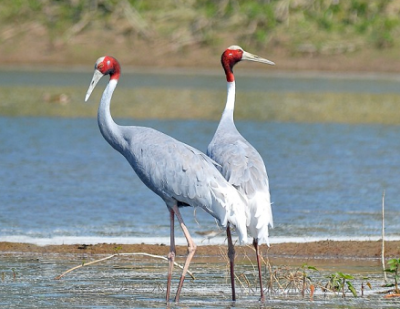
The Indian state of Uttar Pradesh has declared the sarus crane as its official state bird. An Indian 14-seater propeller aircraft, the Saras, is named after this crane.
The Sarus crane is the tallest flying bird in the world standing 152-156 cm tall with a wingspan of 240cm. It has a predominantly grey plumage with a naked red head and upper neck and pale red legs. It weighs 6.8-7.8 Kgs. It is a social creature, found mostly in pairs or small groups of three or four. Known to mate for life with a single partner, its breeding season coincides with heavy rainfall in monsoon. Nests are constructed on water in natural wetlands or in flooded paddy fields. Usually a clutch has only one or two eggs, which are incubated by both parents for a period of 26 to 35 days. The juveniles follow their parents from the day of birth.
The main threat to the Sarus crane in India is habitat loss and degradation due to draining the wetland and conversion of land for agriculture. The landscape of its historic range is rapidly changing due to construction of highways, housing colonies, roads, and railway lines. More recently, many deaths have been recorded due to collision with power lines. Also, due to the increase in agricultural land, Sarus cranes are left with no choice but to forage in these fields, and as a result ingest pesticides, which lead to poisoning.
The Sarus crane has three disjunct populations in the Indian sub-continent, south-east Asia and northern Australia with an estimated global population of 25,000-37,000 individuals. In the Indian subcontinent, it is found in northern and central India, Terai Nepal and Pakistan. It was once a common site in the paddy fields of Uttar Pradesh, Bihar, Rajasthan, West Bengal, Gujarat, Madhya Pradesh and Assam. Their population is now on the decline with only 15,000-20,000 found in India, a majority of which are in Uttar Pradesh. The Sarus crane is known for its ability to live in association with humans, inhabiting open, cultivated, well watered plains, marshlands and jheels. These areas suit them well for foraging, roosting and nesting.
Credit : WWF
Picture Credit : Google




